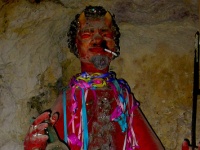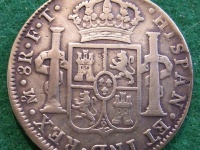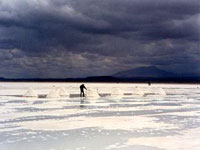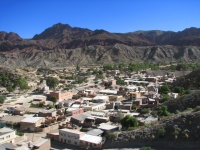Things to do in Potosi
Sightseeing in Potosi is a joy that mainly revolves around its beautiful, UNESCO-approved colonial churches and convents. Highlights include San Lorenzo Church, the San Francisco of Potosi Convent, the Santa Teresa Convent Museum, and the Catedral de la Ciudad de Potosi. The Museo de la Casa de la Moneda is another must-see attraction. It was once the Spanish Royale Mint House.
Historically and economically speaking, Potosi is built on silver and the sweat of miners. Many travellers feel their visit is incomplete without a tour of the cooperative mines, where locals continue to work. Tours of these mines are readily available and very interesting. That said, travellers should educate themselves on the abysmal conditions before joining a tour group, as some will find the experience distressing.
Visitors can usually get around Potosi on foot, given that the main tourist attractions are clustered together in the compact historic centre. However, the high altitude can make walking a bit strenuous. Visitors who wary of too much walking can rely on the city's many taxis. Otherwise, the main bus terminal is about a 30-minute walk from the city centre.

Cooperative Mines of Cerro Rico
Entering the mines is like stepping back in time, given that current mining conditions remain untouched by modern advances. Indeed, they're much the same as when the Spanish used A…
Cooperative Mines of Cerro Rico
Entering the mines is like stepping back in time, given that current mining conditions remain untouched by modern advances. Indeed, they're much the same as when the Spanish used Andean peasants as slave labourers to extract the rich silver deposit. The experience involves guided tours leading groups along the narrow tunnels and up rickety ladders, stopping along the way to chat to working miners. Visitors won't struggle to find a tour operator offering trips out of Potosi, and the best guides tend to be former miners. Travellers should also consider that these trips, though fascinating, are potentially dangerous. For ethical reasons, tourists should perhaps remember that many people in contemporary Bolivia have no choice but to accept this hazardous life.

Museo de la Casa de la Moneda
Spanish colonists used the Casa de la Moneda as their Royal Mint House, where they turned the silver they mined into coins destined for Spain. The institution is one of Bolivia's b…
Museo de la Casa de la Moneda
Spanish colonists used the Casa de la Moneda as their Royal Mint House, where they turned the silver they mined into coins destined for Spain. The institution is one of Bolivia's best museums, and covers the history of silver production in the country. Visitors will encounter coins and coin stamps, and assemblies of mule-driven wooden cogs that would beat silver into the right width for coining. They will also see a fascinating collection of religious paintings from the Potosi school (Baroque artwork).
Address Ayacucho S/N, Villa Imperial de Potosí, Bolivia
Website www.casanacionaldemoneda.org.bo
Opens 9am-12pm; 2.30pm-6.30pm - Tuesday to Sunday(closed on Mondays).

Salar de Uyuni
Salar de Uyuni is the world's largest salt flat, which exists courtesy of a prehistoric lake that went dry. This region is one of Bolivia's most spectacular natural attractions, an…
Salar de Uyuni
Salar de Uyuni is the world's largest salt flat, which exists courtesy of a prehistoric lake that went dry. This region is one of Bolivia's most spectacular natural attractions, and is a photographer's delight. Its surreal landscape combines salt pans, wandering llamas and wind-eroded rock formations. A landmass covered in towering cacti called, Isla de Pescadores (the Pescadores Islands), lies in the middle. Laguna Colorada and Laguna Verde are other isolated marvels in Salar de Uyuni. One is a fiery-red lake; the other is a deep blue. Both are inhabited by flamingos and surrounded by extinct volcanoes. Nearby Sol de Manana reeks of sulphurous gases from geysers, fumaroles and bubbling mud-pools. The village of Uyuni is located to the southeast of the Salar, and is the best base from which to explore the area. Travellers can arrange tours from there. 'Salt Hotels' around the periphery of Salar are a unique form of accommodation, where everything (walls, furniture, etc.) is made from salt blocks cut from the flats.

Tupiza
Located in Potosi Department, Tupiza mining town serves as a popular base for tours of nearby San Vicente, which is the region's major drawcard. San Vicente's 'Wild West' history f…
Tupiza
Located in Potosi Department, Tupiza mining town serves as a popular base for tours of nearby San Vicente, which is the region's major drawcard. San Vicente's 'Wild West' history features Butch Cassidy and the Sundance Kid: two of the world's most famous outlaws. Both of them died in Tupiza after fleeing the US in 1901. They were gunned down by the Bolivian army. Organised tours from Tupiza lead tourists along the 'death trail' of Butch and Sundance, giving visitors the chance to follow the outlaws' last days. The trail leads all the way to their supposed final resting place.



